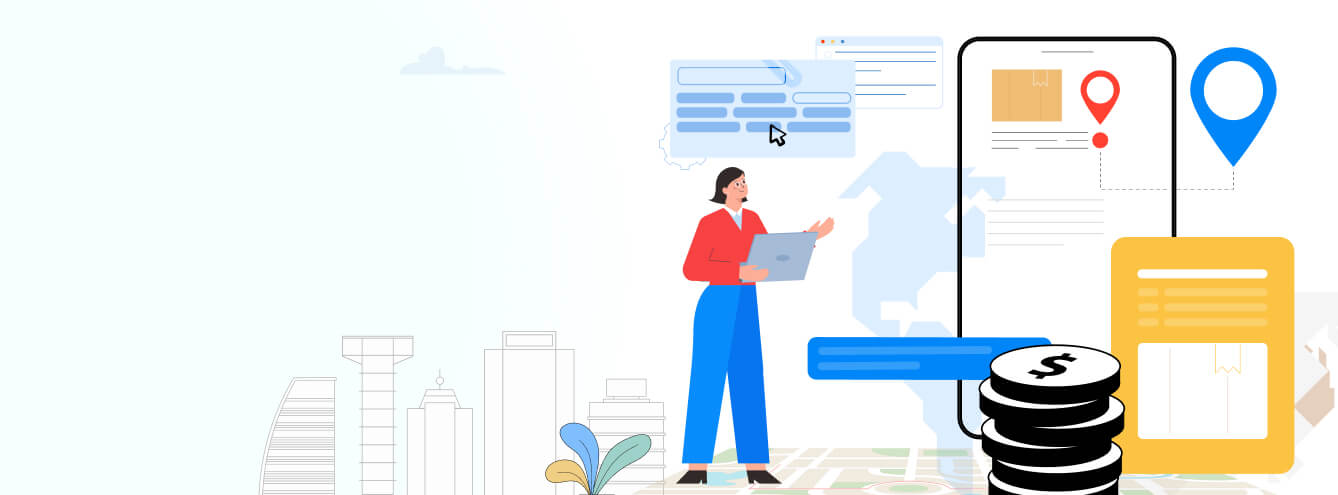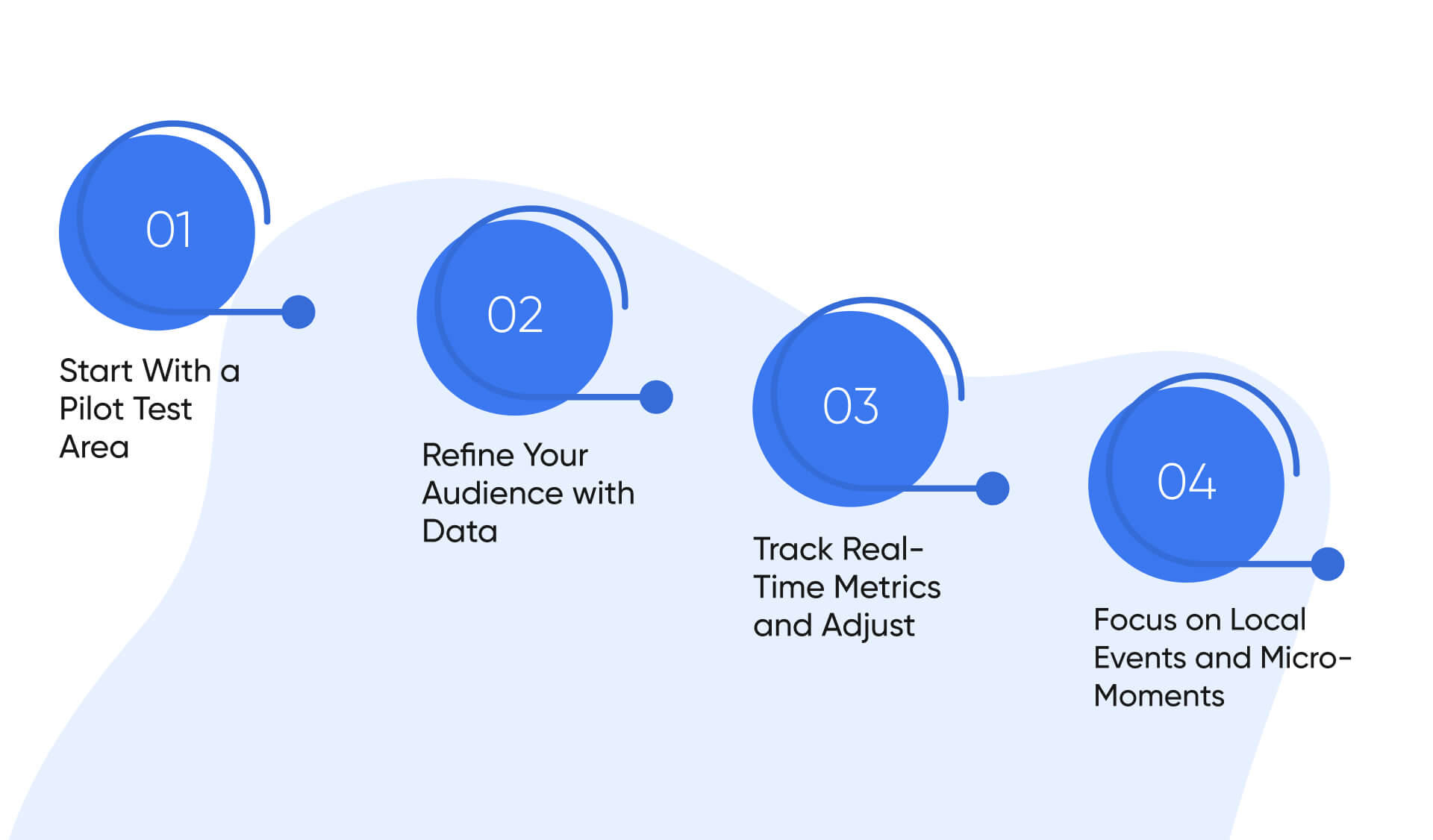How Much Does Geofencing Marketing Cost in 2025? Full Pricing Guide & ROI Hacks

 13 min
13 min
Geofencing marketing has quietly become one of the most accurate tools in a marketer's toolbox in the quest to acquire hyper-targeted digital awareness. But with accuracy comes the question: how much does it really cost to put a virtual fence around your customer's world? As 2025 changes the digital footprints of many businesses, figuring out how much geofencing marketing costs isn't just about the money; it's also about figuring out how location-based engagement works.
For digital marketing service providers, knowing how much geofencing costs might mean the difference between giving vague offers and running campaigns that are very focused on ROI. This blog talks about the figures, the variables, and the value proposition without making it look fancy. We'll get rid of the fluff, explain what affects prices, compare it to other location-based models, and show you how to make it lean and profitable. This guide makes sure that you're not only at the appropriate place but also getting the best deal, whether you're working with a local store or a major brand.
What Is Geofencing Marketing?
Geofencing marketing is a type of advertising that employs GPS, Wi-Fi, RFID, or cellular data to make a virtual barrier, or geofence, around a certain area. When a device crosses this line, it starts a set marketing action, including delivering a notification, pushing an ad, or logging user behavior for retargeting.
But this isn't just about being close; it's also about timeliness, relevance, and real-world aim. Picture a coffee shop that tries to get people who are walking by a competing chain in the morning. Or a car dealership that tries to get customers to buy anything as soon as they step onto a competitor's lot. Geofencing lets marketers meet customers where they are, physically, with accuracy and customization.
Geofencing marketing connects online data with offline activity for digital marketing service providers. It gives firms an edge in getting foot traffic from people who are interested in their products without wasting money on ads that don't reach the right people. It also gives real-time analytics and makes customers more interested in the brand.
How to Estimate Your Geofencing Marketing Cost?
Need real numbers for your business? Our specialists can walk you through personalized cost breakdowns based on your goals, targeting zones, and ad frequency.
Request Your Custom Cost Report
How Does Geofencing Marketing Pricing Work?
To sell geofencing marketing confidently and grow campaigns economically, you need to know how its pricing works. Geofencing cost models are different from flat-fee digital ads since they depend on a mix of impressions, reach, targeting accuracy, and campaign length. At its heart, price is based on CPM (cost per thousand impressions), which usually falls between $5 and $15, but can go higher if you use advanced targeting or are in a competitive area.
Depending on how the campaign is set up, there are also different levels of costs. Some sellers impose setup fees, while others include monthly minimums or platform licensing fees in their prices. The more complicated the campaign is, like using behavioral data to activate advertising or adding CRM retargeting, the more likely you are to encounter extra charges. You might also have to pay for creative assets and analytics dashboards individually.
As platforms start to use AI-driven triggers and real-time data in 2025, pricing models will likely move away from flat metrics and toward performance-based tiers. For marketing service providers, it's important to know how these costs will affect expenditure, give accurate estimations, and get the most return on investment for their clients.
Key Factors Affect Geofencing Marketing Cost

Every geofencing campaign comes with its own set of moving parts. Pricing isn’t a one-size-fits-all affair; it flexes based on how targeted, creative, and competitive your campaign needs to be. Below are the most critical variables that directly influence geofencing marketing cost.
1. Target Radius & Geographic Area
The wider the fence, the more gadgets it catches, and the more it costs. Running a campaign in a crowded city like New York will cost a lot more than running one in a remote community. Why? There is a lot of competition for ad space, data, and users. In high-intent areas, narrower fences often provide you a higher return on investment with fewer impressions. When setting the radius, digital marketers need to find a balance between reach and relevancy while keeping their budget and brand goals in mind.
2. Audience Targeting and Behavioral Data
When it merely looks at location, basic geofencing costs less. But when you add in things like purchase history, app usage, or visit frequency, the game changes. It takes money to be precise. Behavioral overlays usually need you to partner with a third party for data or pay for access to a premium platform. But they do make people more interested and more likely to buy. Marketers have to choose between spending more on targeted ads that work or casting a wide net that doesn't work as well. Smart targeting makes every impression count.
3. Ad Frequency & Duration
More impressions mean more budget. If a campaign hits the same user five times a day versus once a week, costs climb quickly. Similarly, campaigns that run continuously over months will rack up higher geofencing costs than short, punchy bursts around key events. Frequency caps help manage this, but smart marketers know when to go heavy (product launches, limited-time offers) and when to scale back. Duration and frequency must sync with campaign goals, not just budgets.
4. Platform and Technology Used
The backend matters. Are you using Google Ads with location extensions or a specialized geofencing DSP like Simpli.fi or Reveal Mobile? Tech choice influences both capability and cost. Platforms with real-time analytics, heat mapping, and CRM sync charge more but deliver far deeper insights. White-label solutions for agencies may also add margins. Choosing the right platform means weighing technical depth against budget. For high-stakes campaigns, investing in robust tech often justifies the premium.
5. Creative and Ad Design Expenses
No matter how smart the fence, poor creative won’t convert. Custom HTML5 banners, rich media, and video assets come at a cost. Many agencies overlook this line item while budgeting geofencing campaigns, but compelling design is non-negotiable for engagement. Creative tailored to location, like referencing local landmarks or events, tends to perform better and may cost extra in production. Design isn't fluff; it's the trigger. Every well-placed pixel counts when you're paying for every impression.
Confused About Geofencing Marketing ROI Potential?
Understand which pricing model works best for you—CPM, CPC, or CPA. Get a detailed analysis to compare spending vs. returns based on your niche and audience.
Book a Free ROI Consultation
Average Geofencing Marketing Cost in 2025
As of 2025, the average geofencing marketing cost has become more transparent but still varies widely depending on execution. With increased adoption across industries, marketers are seeing pricing that ranges from accessible to aggressive depending on how deeply one wants to personalize the experience. What’s clear is this: geofencing isn’t a luxury spend anymore. It’s a mainstream, ROI-positive channel, and the pricing reflects its maturity.
National Averages (USD)
In the United States, the average geofencing cost runs between $6 and $15 CPM (cost per thousand impressions). Most campaigns fall within the $8 to $12 range when factoring in basic targeting. However, advanced features like real-time behavioral triggers, cross-platform syncing, and CRM integrations can push costs closer to $20–$25 CPM.
Setup fees typically range from $500 to $2,000, especially if you’re working through an agency or a premium platform. Monthly campaign budgets can start at $1,500 but often climb well beyond $10,000 for national retail chains or franchise models.
Industry-Specific Benchmarks
Pricing shifts dramatically based on your sector. For example:
- Retail and QSR (Quick Service Restaurants): $8–$12 CPM, with higher volume targeting
- Automotive Dealerships: $12–$20 CPM, often layered with competitor geofencing
- Healthcare Clinics: $10–$18 CPM due to HIPAA-compliant targeting tech
- Real Estate: $15–$25 CPM, especially for high-net-worth geographies
- Events and Entertainment: $6–$10 CPM, but often with higher burst frequency
These aren’t just ballpark figures; they reflect where brands are actually spending. Smart digital marketing providers know these benchmarks cold because they inform not just cost but client confidence. Aligning budget with vertical-specific averages makes your proposals sharper and your results more believable.
Geofencing Marketing vs. Other Location-Based Advertising Costs
Not all location-based advertising is created equal. Geofencing offers precision and real-time engagement, while other methods like beacon marketing or geotargeting either lack scale or real-time automation. So how do costs compare?
Beacon Marketing, which relies on physical hardware installed in stores, has lower media costs but higher upfront tech expenses. It’s best for indoor use cases, but the lack of flexibility limits reach.
Geotargeting, often done through platforms like Google or Facebook, is typically cheaper, with CPMs as low as $3–$6. But it only targets based on broader location zones think zip codes, not street corners. The trade-off is imprecision. You might hit users near your store, but not necessarily walking past it.
Geofencing, by contrast, blends real-time triggers with defined digital perimeters, offering a more intelligent spend. While geofencing marketing costs tend to be higher on the surface, its ability to drive offline action (like store visits or event attendance) often justifies the additional investment.
In short, if the campaign’s success depends on timely, location-specific engagement, geofencing wins even if it costs more upfront. It's not just about reach; it's about relevance.
What Influences Geofencing Marketing Cost in 2025?
Not all campaigns are built the same. Get an expert audit to understand how creative quality, location density, and tech stack impact your final costs.
Get a Campaign Cost Audit
Cost-Effective Tips for Geofencing Campaign Budget

You don’t have to blow your budget to see results. Smart optimization can stretch every dollar and increase campaign precision. Here are field-tested ways to manage geofencing costs without compromising performance.
Start With a Pilot Test Area
Instead of blanketing an entire city, start with one high-traffic zone or competitor hotspot. A smaller radius reduces initial ad spend while delivering targeted insights fast. Pilot campaigns let you validate audience behavior, creative performance, and tech setup before scaling. It’s a low-risk way to learn what works without the budget burn. For agencies managing multiple clients, this tactic minimizes waste and helps deliver early proof-of-concept wins.
Refine Your Audience with Data
Generic targeting is expensive and ineffective. Use first-party data, CRM segments, or third-party tools to narrow your audience by behavior, intent, or interests. The tighter the persona, the lower the wasted impressions. If your campaign targets local gym-goers, don’t settle for ‘people nearby’; target those who frequent health clubs at peak hours. When the audience is smarter, the geofencing marketing cost becomes leaner and more rewarding.
Track Real-Time Metrics and Adjust
Geofencing is not a fire-and-forget tactic. Monitor performance in real-time CTR, foot traffic, and conversions, and tweak frequency caps, ad creative, or time windows. Many platforms now offer heatmaps and live dashboards. Adjusting on the fly prevents budget drain and ensures your spending matches user engagement trends. Staying agile saves money and improves long-term ROI.
Focus on Local Events and Micro-Moments
One of geofencing’s biggest strengths? Micro-timing. Target local events, sporting venues, and seasonal hotspots. Whether it’s a concert crowd or a farmer’s market, these micro-moments create intent-rich windows where ads resonate deeply. Short bursts around these events often outperform longer, generic campaigns. By aligning your fence with the right place and time, you increase impact while managing geofencing marketing costs with surgical precision.
Tools & Platforms That Impact Geofencing Marketing Cost
The tools you use will affect both what you can do and how much money you make. Google Ads and other entry-level systems offer basic geotargeting, but specialized Demand-Side systems (DSPs) like Simpli.fi, GroundTruth, Reveal Mobile, and Bluedot give you genuine geofencing capability.
These platforms have capabilities including dynamic geofencing, footfall attribution, cross-device retargeting, and connections to customer relationship management (CRM) systems. Of course, such extra features come with license fees or minimum purchases. For instance, Simpli.fi usually needs a monthly commitment of $1,000 to $2,500, while premium features on sites like Bluedot can raise CPM prices.
Think about the backend in addition to the media charges. Adding integrations with CRMs, ad servers, or analytics tools might make things more complicated. But these platforms are worth the money because they offer precise targeting, attribution, and performance visibility.
In 2025, marketing service providers can't afford to skimp on tech. Using outdated or stripped-down platforms to save on geofencing cost often ends up costing more in lost opportunity, weak engagement, and poor reporting.
Is Your Budget Aligned with Geofencing Marketing?
Stop guessing. Find out how much you should spend on hyper-targeted ads that convert. We'll help define your budget based on performance benchmarks.
Calculate Your Ideal Budget
How Edifying Voyages Helps You Optimize Geofencing Marketing Cost
At Edifying Voyages, we don’t just manage location-based campaigns; we engineer geofencing strategies that convert. Our approach isn’t about throwing virtual fences on a map and hoping for foot traffic. We understand that geofencing marketing cost can spiral if not handled with intelligence and precision. That’s where our expertise comes in.
We begin by designing tightly calibrated geofencing zones based on real customer movement, not assumptions. Whether it’s competitor conquesting, hyperlocal event targeting, or layered behavioral campaigns, we ensure every dollar spent is tied to clear intent signals. Our team uses premium DSPs, dynamic creative tools, and footfall attribution technologies to streamline performance without inflating geofencing cost.
More importantly, we don’t operate in the dark. Every campaign comes with real-time dashboards, granular reporting, and actionable insights. We show clients how ads perform not just in clicks but in actual store visits, service calls, or sign-ups.
Edifying Voyages empowers digital marketing service providers with transparent planning, adaptive campaign execution, and post-campaign learnings that refine future spending. We don’t believe in bloated budgets or generic ads. We believe in performance marketing, tailored to location, time, and human behavior.
In 2025, when brands demand proof for every penny spent, we help you make geofencing cost not just justifiable but profitable.
Should You Hire a Geofencing Marketing Agency?
Hiring a geofencing marketing agency isn’t just about outsourcing a task; it’s about tapping into specialized skills and tools that elevate campaign efficiency. While DIY options exist, managing geofencing at scale requires nuanced strategy, platform expertise, and constant optimization. Otherwise, geofencing marketing cost can quickly become an unchecked expense.
An experienced agency understands the difference between targeting a five-mile radius versus a five-minute drive time and how that affects both impressions and outcomes. From zoning strategies and audience layering to compliance and ad creatives, the right agency helps you navigate complexity without losing ROI focus.
Most importantly, agencies offer access to premium DSPs, audience data sources, and reporting frameworks not easily available to individual marketers. They also keep up with evolving geofencing trends, regulatory updates, and tech innovations so you don’t have to.
In a landscape where precision drives profit, partnering with an agency isn’t an overhead; it’s an investment in doing location marketing right.
How to Optimize Geofencing Marketing on a Small Budget?
Smart doesn't mean expensive. Discover high-performing, low-cost campaign strategies tailored to your business size and location-specific competition.
Talk to a Budget Strategist Now
Conclusion
Geofencing isn't just a niche tactic anymore; it's a main strategy for marketers that know where their customers are. But just erecting digital boundaries won't make you successful. It comes from knowing what makes geofencing marketing cost, where to put your money, and how to use the correct technology to turn proximity into performance.
The margin for mistake has gotten smaller because there is more competition and better targeting technologies in 2025. That's why companies like Edifying Voyages are helping offshore digital marketing companies find the right balance between great effect and low cost. We build strategies that move people, not just pixels. These tactics range from campaign architecture to footfall attribution.
It's time to get serious about the expense of geofencing and how you manage it if you want to deliver precision marketing with a verifiable return on investment.
FAQs
The average cost of geofencing marketing in 2025 will be between $6 and $15 CPM, depending on how deep the targeting is and how long the campaign lasts. Advanced features like overlaying data in real time or targeting competitors can raise prices. To acquire good outcomes, a lot of businesses set aside somewhere between $1,500 and $10,000 a month.
Geofencing costs a little more than basic geotargeting or beacon-based marketing because it is more accurate and automated. But it has a better return on investment since it interacts with users in real time based on where they are and what they do. The extra expenditure is worth it because it usually leads to more engagement and conversions.
The size of the geofence, the length of the campaign, the levels of audience targeting, and the ad platform employed are all important factors that affect costs. The budget also goes up when you add creative complexity or sync with CRM data. Strategic planning helps keep these things in check so that costs are lower.
Yes, small businesses can keep geofencing costs down by starting with ads that only cover a small area or are centered on events. A lot of platforms let you set a flexible budget, which means you can grow it even with a small amount of money. Starting with a pilot lets you test the value before you roll it out fully.
While it’s possible to DIY through basic ad platforms, hiring a specialized agency ensures deeper strategy, better tech access, and smarter optimization. Agencies understand zoning, real-time metrics, and ad compliance. Their involvement often leads to stronger ROI and fewer wasted impressions.
To get an accurate picture of ROI, keep an eye on KPIs like impressions, click-through rate, footfall attribution, and conversions. A lot of platforms now have live dashboards that show how many people saw an ad and then went to the store or did something else. Ongoing analysis helps improve spending and performance over time.




